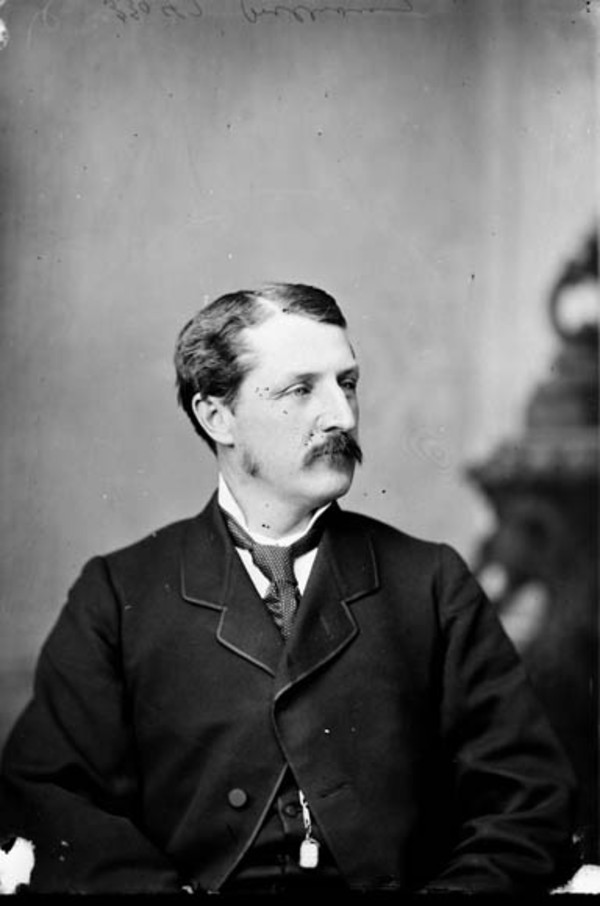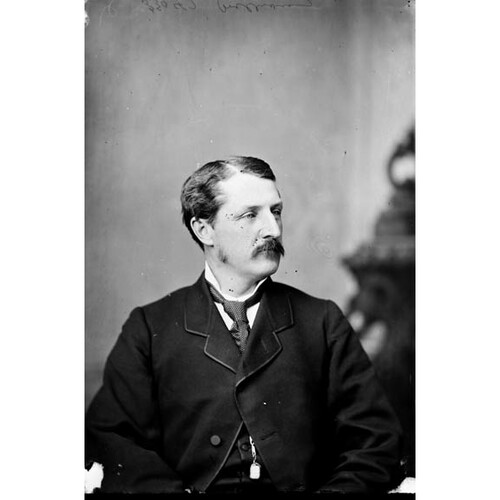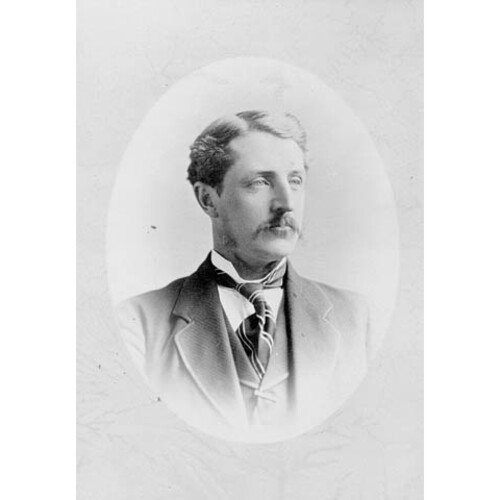WILLIAMS, ARTHUR TREFUSIS HENEAGE, militia officer, businessman, and politician; b. 13 June 1837 at Port Hope, Upper Canada, eldest son of John Tucker Williams, mha for Durham and first mayor of Port Hope, and Sarah Ward, daughter of Thomas Ward, judge and registrar of Durham County; m. in 1859 Emily W. Seymour, daughter of Benjamin Seymour, later a senator, and they had five children including Lieutenant-Colonel Victor Arthur Seymour; d. 4 July 1885 aboard the steamer Northwest on the North Saskatchewan River, near Fort Pitt (Sask.).
Arthur Williams grew up at Penryn Park, his father’s estate at Port Hope, attended Upper Canada College as a contemporary of Edward Blake*, and inherited major holdings when his father died in 1854. After a year in the law office of James Scott and Nesbitt Kirchhoffer in Port Hope, he finished his education at the University of Edinburgh and travelled extensively in Europe. Although he enrolled with the Law Society of Upper Canada in 1859, he was not called to the bar. Instead, he “delighted to call himself a farmer,” managed his property, and participated in Port Hope’s mushroom expansion in the 1860s.
In 1867, Williams was elected to the provincial legislature as a Conservative member for East Durham. He was returned by acclamation in 1871. Handsome, popular, and unassuming, he was by that time a justice of the peace, a real estate agent, a director of the Midland Railway of Canada, and chairman of the Port Hope harbour commission. In 1873 he launched the Midland Loan and Savings Company and served as its president. To his constituents, a major achievement was negotiating a reduction of Hope Township’s notorious indebtedness to the municipal loan fund from $115,207 to only $34,949. He accomplished this by persuading the province to assume much of the liability. In 1875 he did not stand for re-election to the provincial legislature but in 1878 he defeated a Liberal to win the seat in the House of Commons for East Durham, to which he was reelected in 1882.
In the federal house Williams spoke rarely but worked for his East Durham constituents in the small change of political patronage and public works. Experience and loyalty brought prompt appointment as party whip in 1878. Political influence was also a useful adjunct for Williams’ chief hobby, the militia.
From his father, who had led the local militia in 1837, Williams inherited enthusiasm for the military and a sense that leadership was a social obligation. On 17 Oct. 1862 he had been appointed captain of one of Port Hope’s three volunteer militia companies. In 1865–66 he spent the winter with his company on the St Clair frontier, watching for Fenian attacks. In 1866 he commanded a provisional militia battalion at Kingston. Later that year, on 16 November, when rural militia companies were formed into battalions, he took command of the 46th East Durham Battalion, a post he held for almost 19 years until his death.
As a “parliamentary colonel,” he secured such favours as the command of the Canadian rifle team which competed at Wimbledon (now part of Greater London), England, in 1880. By speaking on behalf of the rural militia in the house Williams upheld it against the more efficient city corps. In 1883, rebuked by Major-General Richard George Amherst Luard* for insubordination during a discussion concerning parliamentary control of the militia, Williams used his political influence to help ensure the general’s prompt removal. In 1885, as the British empire thrilled to the attempted rescue of General Charles George Gordon at Khartoum and drifted close to war with Russia, Williams was one of several Canadian militia colonels who offered to raise battalions for imperial service. His prominence even encouraged rumours that he might be the next lieutenant governor of Ontario.
In fact, Williams’ search for a military career was not attributable, as Sir John A. Macdonald* suggested, to his being “anxious for excitement or notoriety” as much as it was to the temporary disorder of his financial affairs. Particularly, he had invested $50,000 in grazing land in the northwest, without apparent return. Ironically, it was there that he would find his military opportunity. When rebellion broke out at the end of March 1885 [see Louis Riel], Williams was given command of the Midland Battalion, a collection of rural companies from eastern Ontario. Sending a regular stream of advice and criticism to the prime minister and other officials, Williams set off for the front on 6 April 1885. After having travelled along the uncompleted route of the Canadian Pacific Railway north of Lake Superior, he arrived on the Northcote by the South Saskatchewan River with two companies in time to join Major-General Frederick Dobson Middleton*’s column before the battle at Batoche (Sask.). On the fourth day of the battle he precipitated the pell-mell rush of militiamen that cost the Canadians 30 casualties, five dead and 25 wounded, but ended the Métis resistance. To militia officers chafing at Middleton’s leadership, Williams became the hero of the campaign. Heroism was enhanced by martyrdom. Hardship, exertion, bad food, and sleeping on muskeg were all blamed when Williams collapsed on 1 July. He was carried to the captain’s cabin of the steamer Northwest. “Well, it would be hard lines if I should be bowled over now,” he allegedly remarked. On the morning of 4 July, after three days of fever and delirium, he was dead.
Colonel Williams was the only nationally known figure to die in the northwest campaign and his body was brought home in state. A huge funeral was held in Port Hope where citizens erected a statue in his honour. Parliament voted his orphaned children a special pension. Then, like most heroes, he was gradually forgotten. To Charles Arkoll Boulton*, a contemporary, Williams “represented what might be termed Young Canada”; to posterity, he reflects a model of the patriotic landed gentleman, using his wealth and position for dignified public service, accepting payment in the currency of honour and prestige. In short, Arthur Williams was an anachronism.
A. T. H. Williams papers are in the possession of Mr Michael Wladyka, Port Hope, Ont.
PAC, MG 26, A; MG 27, I, D3. [C. A.] Boulton, Reminiscences of the North-West rebellions, with a record of the raising of Her Majesty’s 100th Regiment in Canada . . . (Toronto, 1886). Can. House of Commons, Debates, 13 April 1880. Telegrams of the North-West campaign, 1885, ed. Desmond Morton and R. H. Roy (Toronto, 1972). Globe, 16 July 1885. Canadian biog. dict., I. Cyclopædia of Canadian biog. (Rose, 1886). Wallace, Macmillan dict. G. T. Denison, Soldiering in Canada: recollections and experiences (Toronto, 1900). Desmond Morton, The last war drum: the North West campaign of 1885 (Toronto, 1972); Ministers and generals: politics and the Canadian militia, 1868–1904 (Toronto and Buffalo, N.Y., 1970).
Cite This Article
Desmond Morton, “WILLIAMS, ARTHUR TREFUSIS HENEAGE,” in Dictionary of Canadian Biography, vol. 11, University of Toronto/Université Laval, 2003–, accessed December 31, 2025, https://www.biographi.ca/en/bio/williams_arthur_trefusis_heneage_11E.html.
The citation above shows the format for footnotes and endnotes according to the Chicago manual of style (16th edition). Information to be used in other citation formats:
| Permalink: | https://www.biographi.ca/en/bio/williams_arthur_trefusis_heneage_11E.html |
| Author of Article: | Desmond Morton |
| Title of Article: | WILLIAMS, ARTHUR TREFUSIS HENEAGE |
| Publication Name: | Dictionary of Canadian Biography, vol. 11 |
| Publisher: | University of Toronto/Université Laval |
| Year of publication: | 1982 |
| Year of revision: | 1982 |
| Access Date: | December 31, 2025 |





